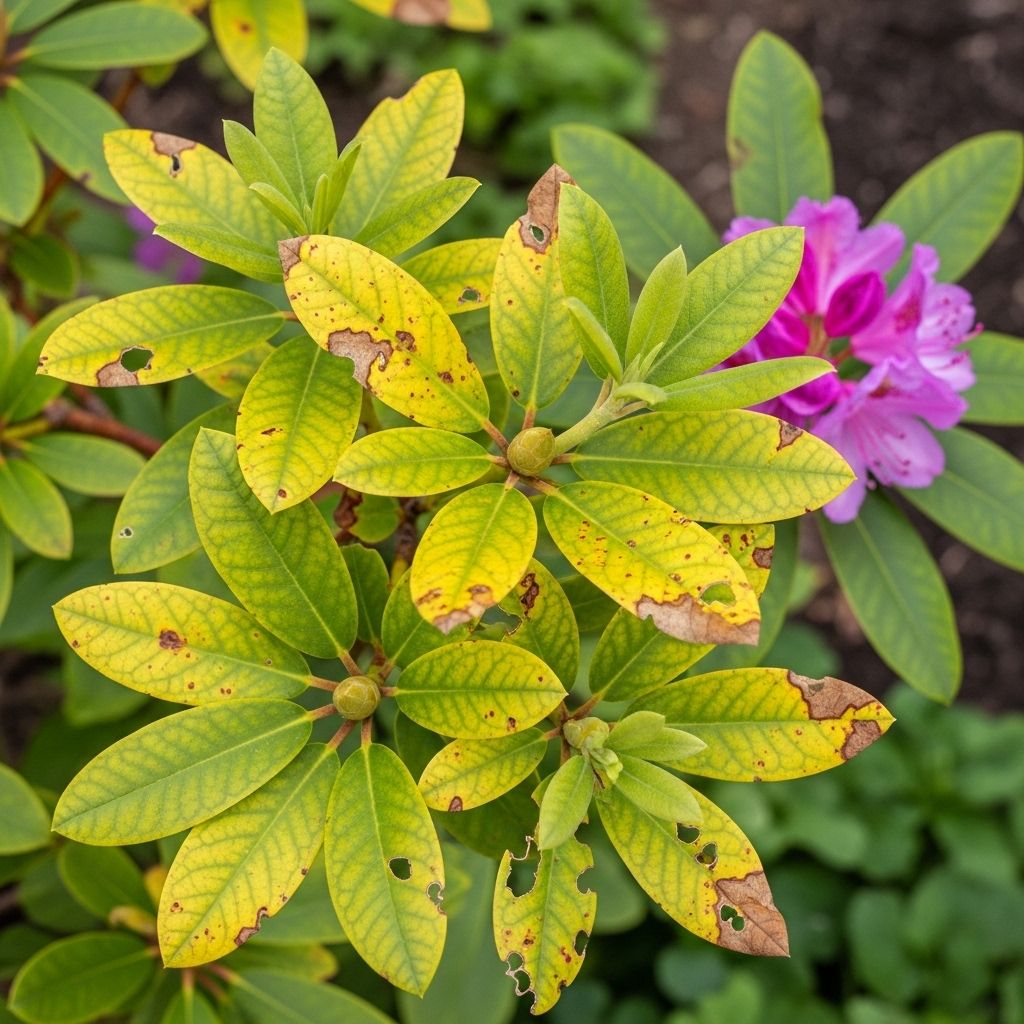11 Common Rhododendron Problems and How to Fix Them
Healthy garden shrubs start with balanced soil, proper watering, and vigilant care.

Image: HearthJunction Design Team
Rhododendrons are prized for their spectacular blooms, lush foliage, and ability to brighten shady garden spots. Yet, like any beloved plant, these shrubs can encounter a range of issues that threaten their health and beauty. If your rhododendron is struggling, don’t worry—most problems are manageable with attentive care and the right action plan. This guide covers the most common rhododendron problems you may face, how to diagnose them, and practical solutions to keep your garden thriving.
1. Root Rot
Root rot is one of the most serious threats to rhododendrons. This fungal disease typically develops when plants are grown in poorly draining soils or are overwatered. It’s often caused by pathogens like Phytophthora, which attack the roots and crown of the plant. Symptoms include yellowing leaves (chlorosis), wilting or drooping branches, and mushy or discolored roots when examined.
- Diagnosis: Unusually wet soil, yellowing and wilted leaves, mushy roots upon inspection.
- Solution: If most of the root system is healthy, trim away damaged roots and replant in well-draining soil. Amend native soil or repot containers with a mix that allows excess water to escape. Water only when the top inch of soil begins to dry, aiming for about one inch of water per week.
- Prevention: Perform a drainage test: fill a hole with water and check that it drains within 30–60 minutes. Amend heavy soils with organic matter or sand as needed.
2. Chlorosis (Leaf Yellowing)
Chlorosis appears as yellowing foliage with green veins or an overall pale look. Multiple factors can cause this, including nutrient deficiencies (especially iron), pH imbalance, or root problems like rot.
- Diagnosis: Uniform yellowing of leaves or yellow leaves with green veins, sometimes accompanied by poor growth.
- Solution: Amend the soil to maintain a pH between 4.5 and 6.0. Use chelated iron or wettable sulfur for acidification if needed. Ensure roots are healthy and not waterlogged.
- Prevention: Plant in naturally acidic, well-drained soil rich in organic matter, such as those found in wooded areas.
3. Leaf Spot Diseases
Leaf spot diseases are caused by a variety of fungi and bacteria. They manifest as brown, black, or purple spots on the leaves, which sometimes develop yellow halos. Severely affected leaves may drop prematurely.
- Diagnosis: Distinctive spots on the foliage, often starting at the tip or edges and expanding inward.
- Solution: Remove and dispose of affected leaves. Improve air circulation by spacing plants properly and pruning crowded branches. Water at the base to avoid wetting leaves, and apply fungicides when needed (always follow label instructions).
- Prevention: Avoid overhead watering and excessive fertilizing, both of which can encourage fungal growth.
4. Powdery Mildew
This common fungal disease presents as a powdery white coating on the leaves. It’s often seen in late summer or during humid periods and can weaken the plant if left untreated.
- Diagnosis: White, powdery substance on the upper side of leaves or stems.
- Solution: Remove and destroy infected plant parts. Ensure plenty of air movement by selective pruning. Apply labeled fungicides if the problem persists.
- Prevention: Avoid watering foliage and overcrowding plants.
5. Bud Blast
Bud blast is caused by the fungus Seifertia azaleae. It makes unopened flower buds turn brown, shrivel, and fail to bloom. Sometimes, black bristly hairs appear on the infected buds.
- Diagnosis: Black or brown, dry flower buds with possible bristly hairs.
- Solution: Prune and dispose of all affected buds. Clean up fallen debris beneath the shrub. Fungicides may help prevent spread in severe cases.
- Prevention: Prevent water from splashing onto buds and avoid overcrowding.
6. Petal Blight
Petal blight (Ovulinia azaleae) affects open flowers, causing brown or water-soaked spots that quickly expand and destroy blooms.
- Diagnosis: Spots on open petals, rapid collapse, and mushy appearance of flowers.
- Solution: Remove affected blooms right away and clean beneath the plant. Use fungicides as directed during wet periods.
- Prevention: Good sanitation and air flow, especially during bloom season.
7. Leaf Gall
Azalea or rhododendron leaf gall is caused by Exobasidium japonicum. This fungal disease results in swollen, curled, or fleshy leaves that later turn white and powdery before drying out and falling off.
- Diagnosis: Unnaturally swollen or distorted leaves with a pale or powdery appearance.
- Solution: Remove and destroy all affected leaves as soon as they are noticed.
- Prevention: Avoid overhead watering and maintain good air movement.
8. Insect Pests
Several insect pests can damage rhododendrons, including root weevils, lace bugs, spider mites, and borers.
- Symptoms: Notched leaf edges (root weevils), stippling or yellowing on the upper surface of leaves (lace bugs or mites), and wilting or boring holes in stems (borers).
- Solution: Handpick larger pests like weevils, use insecticidal soap for mites, and apply beneficial nematodes to soil if root pests are present. Prune and destroy infested stems to manage borers.
- Prevention: Monitor plants regularly, keep the area clean, and encourage beneficial insects.
9. Winter Injury
Cold weather, particularly after a dry summer, can damage rhododendron foliage and buds. Some types curl their leaves tightly in response to freezing temperatures as protection, but desiccation and dieback can still occur, especially if there’s been drought stress.
- Symptoms: Brown or scorched leaf tips, curled or rolled leaves that do not recover in spring, dead buds or branches.
- Solution: Prune away dead or damaged growth in early spring. Mulch to protect roots and conserve soil moisture.
- Prevention: Water thoroughly in late autumn before the ground freezes, especially after dry seasons. Use burlap screens for protection in exposed areas.
10. Edema (Water Blisters)
Edema occurs when roots take up water faster than leaves can transpire, leading to small water-soaked blisters on the underside of leaves.
- Diagnosis: Tiny blisters or pimple-like bumps, often on lower leaves.
- Solution: Adjust watering routine to avoid overwatering. Ensure soil drains well and avoid sudden changes in moisture.
- Prevention: Maintain even soil moisture and proper drainage.
11. General Nutrient Deficiency
Rhododendrons require specific nutrients, especially iron, magnesium, and nitrogen. A deficiency can cause poor growth, pale foliage, and weak flowering.
- Symptoms: Faded leaf color, slow growth, and small or few blooms.
- Solution: Apply a specialized rhododendron or azalea fertilizer in spring. Avoid over-fertilizing, which can burn roots.
- Prevention: Use organic mulch such as pine needles or leaf litter to enrich soil naturally.
Prevention and Best Practices
Many rhododendron problems can be avoided with optimal care and garden hygiene:
- Plant in acidic, well-draining, organic-rich soil.
- Water consistently but avoid waterlogged conditions—aim for slow, deep soaks rather than daily surface watering.
- Space shrubs to allow for adequate air flow, preventing fungal and bacterial diseases.
- Prune in early spring to maintain size and remove dead or diseased material.
- Mulch with organic materials to retain moisture and nourish roots.
- Check soil pH annually and amend as necessary.
- Regularly monitor for pests and remove affected plant parts promptly.
Common Rhododendron Problems Table
| Problem | Symptoms | Causes | Solutions |
|---|---|---|---|
| Root Rot | Wilting, yellow leaves, mushy roots | Poor soil drainage, overwatering | Trim damaged roots, replant in well-draining soil |
| Chlorosis | Yellow leaves with green veins | Iron deficiency, high pH, root damage | Acidify soil, apply chelated iron |
| Leaf Spot | Spots on leaves, premature drop | Fungal infection, overhead watering | Remove leaves, improve air flow, fungicide |
| Powdery Mildew | White powder on leaves | Fungal spores, humidity | Prune, remove parts, fungicide |
| Bud Blast | Brown/black buds, no blooms | Fungal parasite | Remove buds, fungicide |
| Petal Blight | Brown, wilted flowers | Fungal infection | Remove flowers, clean debris, fungicide |
| Leaf Gall | Swollen, curled leaves | Fungal infection | Remove galls, improve air flow |
| Insect Pests | Notched leaves, stippling, holes | Weevils, mites, borers | Remove pests, use insecticidal soap |
| Winter Injury | Brown, curled, dead leaves/branches | Cold, drought | Prune, mulch, water in fall, windbreaks |
| Edema | Water blisters under leaves | Overwatering, poor drainage | Reduce watering, improve drainage |
| Nutrient Deficiency | Pale leaves, poor growth | Lack of minerals | Fertilize, organic mulch |
Frequently Asked Questions (FAQs)
Q: Why are my rhododendron leaves turning yellow?
A: Yellow leaves often indicate chlorosis, which can be caused by iron deficiency, a soil pH that’s too high, or root rot. Test your soil’s pH and drainage, and treat accordingly.
Q: How often should I water my rhododendron?
A: Newly planted rhododendrons need water twice a week, while established plants generally need supplemental water only during droughts. Ensure soil is moist but not soggy.
Q: Can I prune or deadhead rhododendrons?
A: Pruning is not required but can help shape the plant and remove dead material. Deadheading spent blossoms is optional, but it can improve appearance and redirect energy to root growth.
Q: What is the best soil mix for rhododendrons?
A: A mix that is acidic (pH 4.5–6.0), high in organic matter, and well-draining is ideal. Avoid aluminum sulfate for acidifying, as it is toxic to rhododendrons.
Q: How do I protect my rhododendrons in winter?
A: Water well before winter, mulch around the base, and use burlap to shield plants from harsh wind or sunscald in exposed locations.
Final Thoughts
Rhododendrons bring vibrant color and structure to landscape design, especially in woodland and shaded gardens. Whether used as privacy screens or container accents, these resilient shrubs can thrive for years with a little care and vigilance. If you encounter any of the issues discussed above, do not panic—diagnosis and prompt action makes all the difference. With the actionable tips found here, you can enjoy healthy, blooming rhododendrons for seasons to come.
References
- https://www.epicgardening.com/rhododendron-problems/
- https://www.epicgardening.com/rhododendrons/
- https://www.tiktok.com/@tsierraauthor/video/7510392942637468959
- http://www.enchantedgardensdesign.com/blog/2025/4/15/spring-2025-rhododendron-damage-in-new-england
- https://www.rhs.org.uk/disease/rhododendron-diseases
Rhododendron Problems Solved: Leaf & Pest Control Tips
Watch this video to learn how to diagnose and treat common rhododendron problems—from leaf yellowing and bud blast to pests like lace bugs. Dive in and learn expert solutions now!
Read full bio of Shinta












